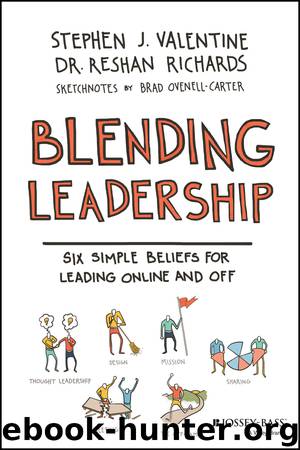Blending Leadership by Valentine Stephen; Richards Reshan; Ovenell-Carter Brad & Reshan Richards

Author:Valentine, Stephen; Richards, Reshan; Ovenell-Carter, Brad & Reshan Richards
Language: eng
Format: epub
Publisher: John Wiley & Sons, Incorporated
Published: 2016-07-18T00:00:00+00:00
In July 2009, writing on his blog, the venture capitalist Paul Graham drew a line in the digital sand. He placed “managers” on one side and “makers” on the other, and then he described the preferred work styles of each group—how they “use time.”
Managers operate out of a “traditional appointment book,” slicing the day into discrete, often small, chunks. Because of their status in organizations, they have the ability to pull others into their schedules. They have the ability to slice up the work of others. Makers prefer to work in very long blocks: “units of a half a day at least.” In this time, they presumably puzzle through code (if they program) or syntax (if they write) or other problems presented by their materials and their goals if they are makers of a different sort.
According to Graham, when we assemble managers and makers in the same organization, we mix two kinds of schedules. Managers relish such an arrangement. After all, they have the power to call as many meetings as they would like to have, whether those meetings deal with urgencies or more “speculative” possibilities. Not so for makers, who view meetings that break up their work as “disasters” or “like throwing an exception.” In the world of programming, throwing an exception means that the program—in this case, the maker's program—jumps from the desired task to another task that now needs to be dealt with, causing the programmer—in this case, the maker—to go into debugging mode.
Graham is a careful thinker, and listening to him carefully pays dividends. What is wrong with breaking up a maker's day, with changing its expected course?
Segmenting a maker's day breaks it into pieces “too small to do anything hard in.” Graham's point? Meetings are often focused on work that is not hard or valuable. Graham's implication? Certain sorts of organizationally acceptable collaborative practices aren't producing anything truly great because they don't establish the conditions for people to tackle truly hard projects. They are poorly designed, and we show up to them out of habit or because we have to.
In 2009, Morton T. Hansen was bringing fifteen years of research to fruition to help us understand the impact of such a default setting. In his book, Collaboration: How Leaders Avoid the Traps, Create Unity, and Reap Big Results, he makes a point that cuts against a truism that many of us have simply accepted: Collaboration is good for us. Not always, Hansen says. “Bad collaboration,” he writes early in his book, “is worse than no collaboration. People scuttle from meeting to meeting to coordinate work and share ideas, but far too little gets done” (Hansen, 2009, p. 1). And he goes further: “Poor collaboration is a disease afflicting even the best companies” (p. 1).
We can move pretty easily from Graham's experience-based observations and Hansen's research-based conclusions to the world of school, where managers and makers collaborate each and every day in predictable, meeting-driven ways. We meet with our classes, our extracurricular teams, and as grade-level
Download
This site does not store any files on its server. We only index and link to content provided by other sites. Please contact the content providers to delete copyright contents if any and email us, we'll remove relevant links or contents immediately.
The Art of Coaching Workbook by Elena Aguilar(48030)
Trainspotting by Irvine Welsh(20042)
Twilight of the Idols With the Antichrist and Ecce Homo by Friedrich Nietzsche(17702)
Fangirl by Rainbow Rowell(7825)
Periodization Training for Sports by Tudor Bompa(7322)
Change Your Questions, Change Your Life by Marilee Adams(6635)
This Is How You Lose Her by Junot Diaz(5753)
Grit by Angela Duckworth(4728)
Red Sparrow by Jason Matthews(4654)
Asking the Right Questions: A Guide to Critical Thinking by M. Neil Browne & Stuart M. Keeley(4563)
Paper Towns by Green John(4163)
Room 212 by Kate Stewart(4097)
Ken Follett - World without end by Ken Follett(3968)
The Sports Rules Book by Human Kinetics(3581)
Housekeeping by Marilynne Robinson(3394)
The Motorcycle Diaries by Ernesto Che Guevara(3325)
Introduction to Kinesiology by Shirl J. Hoffman(3297)
Exercise Technique Manual for Resistance Training by National Strength & Conditioning Association(3285)
Double Down (Diary of a Wimpy Kid Book 11) by Jeff Kinney(3266)
